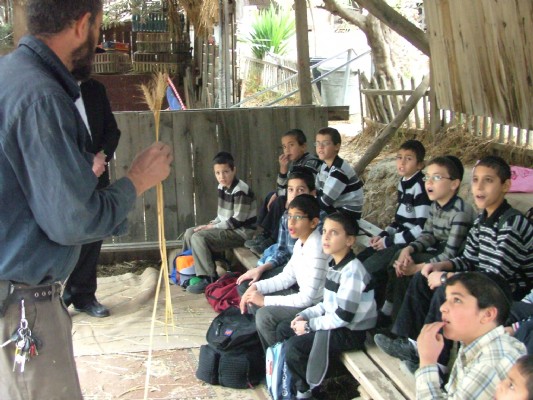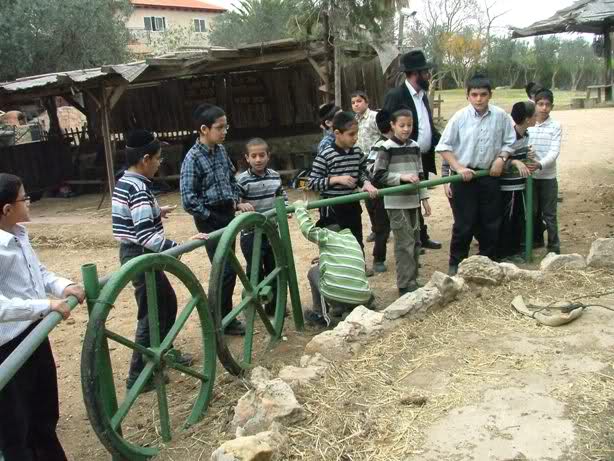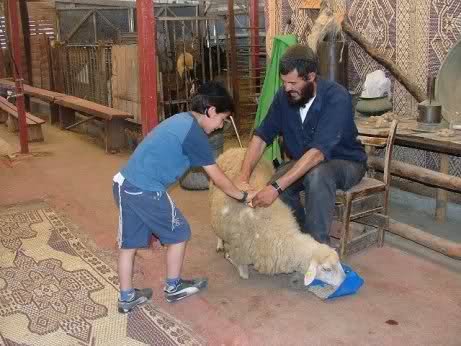"I Had 8000 Shekels Left, Then Decided to Create the Shabbat Farm"
About 25 years ago, David Shalom Kadosh found himself with failing businesses and in massive debt. As a last resort, he decided to create the Shabbat Farm, discovering it to be an amazing opportunity for conveying messages and learning about the prohibited labors of Shabbat.

When learning or talking about the prohibited labors of Shabbat, they almost sound like words from a foreign language. Threshing? What does that even mean? Wool shearing? What tools do you use for that? And what's bundling or winnowing, and what do they mean for us?
To make these concepts clearer, about 25 years ago, David Shalom Kadosh, a resident of Beit Meir, decided to create the 'Shabbat Farm' — a place where one could (almost) encounter all the prohibited labors of Shabbat, understand them up close, experience them, and also enjoy an audiovisual performance in a cave, a milking show, ATV rides, and other attractions appealing to both young and old.

"I Decided as a Last Resort – to Establish the Farm"
Interestingly, Kadosh credits the establishment of the farm to the advice of the 'Pnei Menachem' rebbe of Gur. "It all started when the Rebbe visited our settlement in 1992," he recalls, "He was looking for a house where he could stay, and we offered our home. When he left, he gave us his blessing that our livelihood would be abundant and that we would succeed in all our endeavors.
"At that time," Kadosh adds, "I didn't realize how crucial the Rebbe's blessing would be, because I was working as the owner of two garages in Jerusalem, in Givat Shaul, and making a good living. However, two years later, my garages collapsed due to economic problems, and I didn't know how I would make a living. I had six young children at home and was at a loss. Then my wife suggested: 'Go sell notions in Tel Aviv.' I tried, closed the garages, and dedicated myself fully to selling notions, but it didn't work. Then my wife suggested another idea: 'Open a visitor center.' It seemed like an impossible idea — a visitor center in the remote Beit Meir? But my wife was insistent and convinced me: 'We have our last 8000 shekels, let's invest it in a visitor center and see what happens.' I was still worried because it was all the money we had, but perhaps some divine intuition sparked in me, and I decided to take the plunge, while still burdened with the garages' enormous debts and being constantly harassed by creditors."

And why did you decide that the visitor center would focus on the subject of Shabbat?
"During that time, I was studying the Tractate Shabbat in an evening kollel and was very interested in the subject. I told myself if I was opening a visitor center, it should at least convey Jewish messages. So we chose the theme of Shabbat and used the animals we had and various old tools to illustrate the different labors. Finally, I gave our center the name: 'The Children's and Animals Farm with the Prohibited Shabbat Labors.' It was a long and clunky name, but that's what I thought of. It was the days before Passover, and I decided to promote the farm so children would visit during the holiday. So I drove to Bnei Brak with a truck, loaded my two donkeys dressed festively on it, and drove around the city, distributing advertisements and flyers to residents until the city officials caught me and chased me away."
But in hindsight, it turned out to be worthwhile. During the four days of Passover, more than 4000 people flocked to the Shabbat Farm. "It was unbelievable," he gets emotional, "We started tours every morning at sunrise and finished them late at night. On the very first day, I covered expenses, and quickly paid off more than 100,000 shekels in debts and still had plenty left to live on. After the holiday, talmudei Torah and Beit Yaakov schools started coming, as well as teacher seminars and others who wanted to tangibly study the topic of the 39 ancestral labors. At first, I felt a bit proud that my idea was so successful, but when I saw the extent it reached, I realized I wasn't part of the success — it was entirely divine aid propelling it all."
The Professional Secret: Visualization is Key
Today, if you visit the Shabbat Farm, you'll see the programs offered are diverse, tailored to the participants' levels and ages. "We always start with a gathering of the group," Kadosh explains, "I explain to them what Shabbat is, why it's kept, and its sources. We discuss Midrashim and origins and also explore the Talmudic perspective. Naturally, explanations vary depending on the participants' ages and levels of understanding. Later, we move on to the subject of the 39 ancestral labors and then very tangibly explain what plowing is, what reaping is, what shearing is, and more. When there are children, I don't delve too deeply, but often yeshiva students who are studying Tractate Shabbat for rabbinic ordination visit, and we can sit together for six or seven hours. Hundreds of girls from the old seminar in Jerusalem come here every year. Their rabbi advises them to visit here before their test on the laws of Shabbat and the prohibited labors."
It's clear why children need to visit, but why does a scholar need to visit the farm? It's not so hard to imagine how a plow looks or how sowing works!
"True, and that's precisely our secret; it's about 'visualization,' which is important for all of us, even if we're not aware. Every person, regardless of age, when they see something visually, they understand it better, and it sinks in. We already have a second generation — children with their parents who visited here as children themselves, and surprisingly, they remember things they saw. This proves how deeply ingrained these experiences become. Take, for example, weaving — there's such a significant difference between imagining this labor and seeing it in action. Even plowing — visualizing a plow moving across the furrow and making ridges isn't hard, but what's beneath those ridges? What happens to the soil when plowed? You can't understand that without seeing. Visual images are never quite equal to hearing."

Do you demonstrate all 39 labors at the farm?
"Not exactly all of them, but most. The act of slaughtering, for example, I don't show, nor the act of tanning, because it's done with hides and dangerous materials. But most labors can be seen here. Additionally, I built a small model of the Tabernacle on site, constructed according to what our teachings provide. I built it to show where all these labors concentrate, since the origin of the 39 ancestral labors comes from the labors prohibited during the Tabernacle's construction. In sabbatical years, we also discuss the labors prohibited during the sabbatical."
And how do you personally feel about managing this farm?
"Honestly? It's a huge responsibility because being constantly engaged with the laws of Shabbat also obliges me to keep them strictly, and Shabbat observance isn't simple. Sadly, I often see many Shabbat violations, even within a synagogue. But on the other hand, there is immense satisfaction, and when I hear people leaving the farm saying, 'From now on, our Shabbat will be different,' it clearly proves the worth of my efforts."

